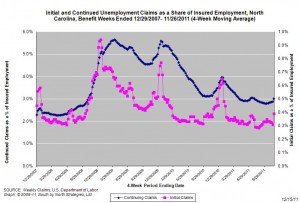16.12.2011
Policy Points
A research note from the NC Budget & Tax Center analyzes differences in unemployment by age. From the note …
Older workers are less likely to be unemployed than younger workers, but when they do experience unemployment, 56 percent are likely to be without a job for 26 weeks or longer.
…
Long-term unemployment continues to be driven by the lack of jobs but is further compounded for older workers by the challenge of finding similar employment despite strong work histories.
…
Due to longer periods of unemployment, older workers are more likely to exhaust their unemployment benefits and can be pushed into unplanned retirement.
16.12.2011
Policy Points
From the Economic Policy Institute’s analysis of the October version of the Job Openings and Labor Turnover Survey (JOLTS) …
… While the job-seekers ratio has been generally slowly improving since its peak of 6.9-to-1 in the summer of 2009, today’s data release marks two years and 10 months—147 weeks—that the ratio has been above 4-to-1. A job-seekers ratio of more than 4-to-1 means that for more than three out of four unemployed workers, there simply are no jobs. In October, there were 10.6 million more unemployed workers than job openings. Furthermore, the lack of job openings relative to unemployed workers is in no way limited to particular industries such as construction—unemployed workers dramatically outnumber job openings across the board, in every major industry.
15.12.2011
Policy Points
Economic policy reports, blog postings, and media stories of interest:
15.12.2011
Policy Points
For the benefit week ending on November 26, 2011, some 24,804 North Carolinians filed initial claims for state unemployment insurance benefits, and 126,279 individuals applied for state-funded continuing benefits. Compared to the prior week, there were more initial and continuing claims. These figures come from data released by the U.S. Department of Labor.
Averaging new and continuing claims over a four-week period — a process that helps adjust for seasonal fluctuations and better illustrates trends — shows that an average of 14,599 initial claims were filed over the previous four weeks, along with an average of 112,122 continuing claims. Compared to the previous four-week period, the average number of initial claims and the number of continuing claims were higher.
One year ago, the four-week average for initial claims stood at 15,880 and the four-week average of continuing claims equaled 121,819.
In recent weeks covered employment has increased slightly and has returned to the 3.73 million level recorded a year ago. Nevertheless, there are still fewer covered workers than there were in January 2008, which means that payrolls are smaller today than they were almost four years ago.
 The graph shows the changes in unemployment insurance claims (as a share of covered employment) in North Carolina since the recession’s start in December 2007.
The graph shows the changes in unemployment insurance claims (as a share of covered employment) in North Carolina since the recession’s start in December 2007.
Both new and continuing claims appear to have peaked for this cycle, and the four-week averages of new and continuing claims have fallen considerably. Yet continuing claims remain at an elevated level, which suggests that unemployed individuals are finding it difficult to find new positions.
15.12.2011
Policy Points
Heather Boushey of the Center for American Progress lays out reasons for continuing emergency unemployment benefits.
But many people may feel like they have no choices left, thus leaving the workforce and the unemployment insurance program. Although the unemployment level decreased to 8.6 percent in November—its lowest point in two-and-a-half years—the drop is due at least in part to people completely leaving the workforce. Unemployed workers face daunting odds finding employment in this labor market. The employment rate—the share of Americans with a job—is 58.5 percent, and it remains just 0.4 percentage points higher than the near-30-year low point reached this July.
…
The extension of unemployment benefits cannot be allowed to expire. Far from giving people a reason not to find work, they have been shown to spare active job seekers from living in poverty, and to boost the struggling economy. This, in turn, can only serve to create the jobs that people both want and need.


 Email Sign-Up
Email Sign-Up RSS Feed
RSS Feed